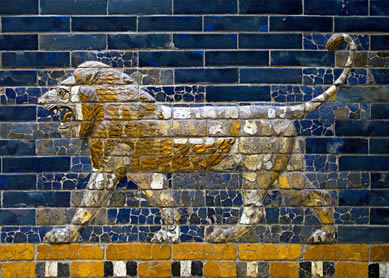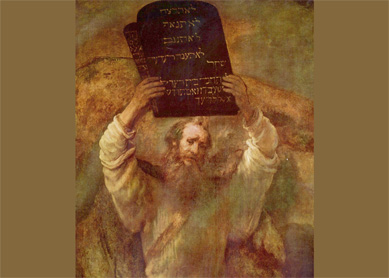Just as knowing something about the 18th century Enlightenment, Colonial American history, and the men who attended the Constitutional Convention will inform your historical understanding of the U.S. Constitution, knowing something about ancient Near Eastern history and culture will deepen your historical understanding of the documents that compose the Hebrew Bible.
Three brief discussions, on ancient Near Eastern scribalism, covenants, and concepts of deity, illustrate how acquiring a deeper historical understanding is the first step in seeing how the Hebrew Bible is both similar to and distinct from other documents from the ancient Near East.
Scribalism: Who wrote texts and what does this %%tell us?
The texts that became the Hebrew Bible were composed by scribes. This is one of the most fundamental issues about the Hebrew Bible. Without scribes, there would be no Bible! Very few people in the ancient world were literate enough to compose the texts we have from the ancient Near East, including the Bible. Scribes were part of the educated elite, and many of them served the great institutions of society, the palaces and temples. Although some scribes wrote everyday documents such as letters and contracts, learned scribes often occupied themselves with more important issues, such as cosmology, rituals, prayers, laws, and revelations. These scribes rarely claimed authorship of their work, although they sometimes attributed their work to ancient luminaries.
Of course, scribes did not simply compose new texts; they also copied old ones. We know from multiple versions of a composition that when scribes copied old texts, they took liberties. They might add new material, delete something unwanted, or rearrange the text entirely. Also, scribes made mistakes. Try writing out a few printed pages longhand and see how many errors you make!
Understanding ancient Near Eastern scribalism explains much about the Hebrew Bible. For example, it is no accident that the Bible focuses on kings and priests and treats topics such as cosmology (
The biblical materials survived long after the demise of ancient Israel, of course. In fact, threats to the survival of the ancient Israelites likely motivated scribes to preserve their cherished traditions. Ancient Near Eastern scribes transmitted some texts for many, many centuries. But none other has had an uninterrupted chain of transmission to the present day as has the Hebrew Bible.
Covenants: What are they and how is Deuteronomy’s use distinctive?
Throughout ancient Near Eastern history, people used formal agreements to broker power and to assign obligations between two parties, usually kings. Scholars calls these agreements treaties or, more often in biblical studies, covenants. Sometimes the kings were equals, and sometimes one member, the suzerain, was superior to the other, the vassal. The most famous ancient Near Eastern treaties derive from the Hittites of the early to mid-second millennium B.C.E. and the Neo-Assyrians, whose kingdom flourished from about the early ninth to the late seventh centuries B.C.E. The Neo-Assyrian kings also imposed treaty-like agreements on entire populations; scholars call these loyalty oaths.
These documents generally treat issues important to kings. Thus, we read in the Hittite treaties, for example, about loyalty to the king, the establishment of frontiers, and military cooperation, among other things. Loyalty to the crown prince and protection of royal succession dominates the Succession Treaty of Esarhaddon, an Assyrian king who ruled from 680 to 669 B.C.E. The sworn parties are even commanded to love the crown prince (see line 266), which clearly means they are to be loyal and obey him.
Although the broad form and general content of ancient Near Eastern treaties were similar over time, there are also intercultural differences and local variations, especially in the content and order of typical elements. The Hittite treaties usually begin with a historical introduction and contain a list of both blessings for obedience and curses for disobedience. The Neo-Assyrian treaties do not have the historical introduction, contain no list of blessings, and have an especially lengthy curse section.
Treaties invoked divine powers to witness the stipulations and the oaths parties took to abide by them. And the physical documents were usually deposited in a temple, where they served as reminders to the gods to enforce them. The Hittite documents also required the vassal to read its text.
Understanding ancient Near Eastern treaties illuminates many passages in the Bible. The most striking example is the book of Deuteronomy, which shows features of both the Hittite and Neo-Assyrian texts. Like those treaties, the heart of Deuteronomy is the stipulations (laws) in chapters 12-26. A historical prologue precedes the stipulations (
What stands out as remarkably distinctive in the Hebrew Bible is the fact that a god rather than a king makes a treaty/covenant with his people. This unique adaptation was probably quite subversive. If, as most scholars think, Deuteronomy (or some version of it) was published during the Neo-Assyrian period when Judah was an Assyrian vassal, then Deuteronomy’s recognition of Yahweh as its divine suzerain intends to reject Assyrian lordship.
Concepts of deity: Is the god of the Hebrew Bible unlike the other ancient Near Eastern gods?
Yes and no. The Bible generally conceives of Yahweh in anthropomorphic terms—that is, with human form (see
However, unlike other ancient Near Eastern peoples, who crafted images of their gods, the Hebrew Bible generally denigrates divine images (see
Also, in contrast to the unabashed polytheism of other ancient Near Eastern cultures, the biblical texts focus on only one god. Of course, the Hebrew Bible was written over a long period of time, and it reflects changing ideas, even about Yahweh. Thus, many biblical texts are henotheistic, that is, they see Yahweh as the most important god among various other gods that existed (see
People are very similar in all cultures by virtue of their shared humanity. But each culture develops some distinctive features that make it unique. Because of the Bible’s status as contemporary Scripture, the tendency is to overemphasize its very real distinctiveness among other ancient Near Eastern documents. From a historical perspective, a more balanced approach that recognizes both its similarities to and its differences from neighboring cultures is the best recipe for understanding the Hebrew Bible.
Bibliography
- Sparks, Kenton L. Ancient Texts for the Study of the Hebrew Bible: A Guide to the Background Literature. Peabody, MA: Hendrickson, 2005.
- Oppenheim, A. Leo. Ancient Mesopotamia: Portrait of a Dead Civilization. Rev. ed. Chicago: University of Chicago Press, 1977.
- Van De Mieroop, Marc. A History of the Ancient Near East, ca. 3000–323 BC. 2nd ed. Malden, MA: Blackwell, 2007.





